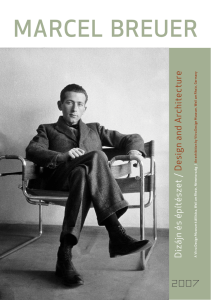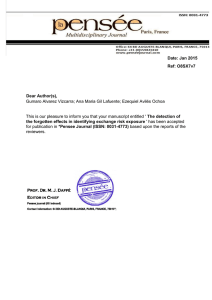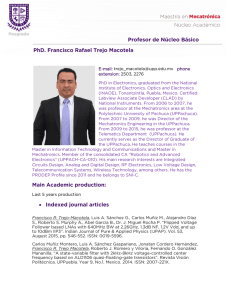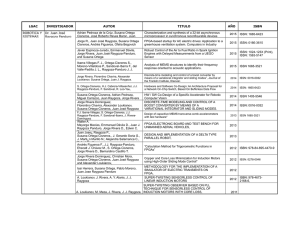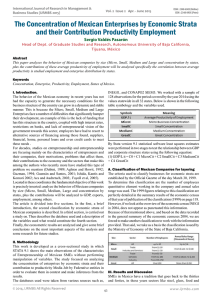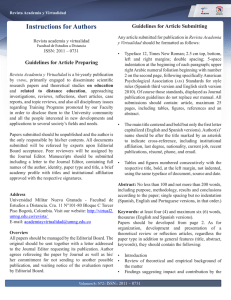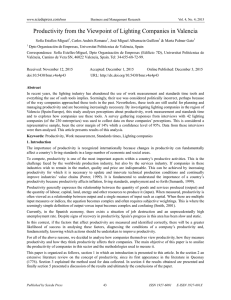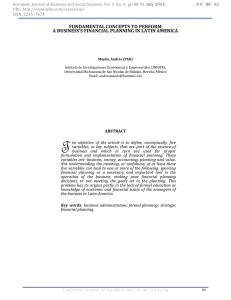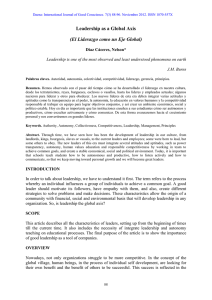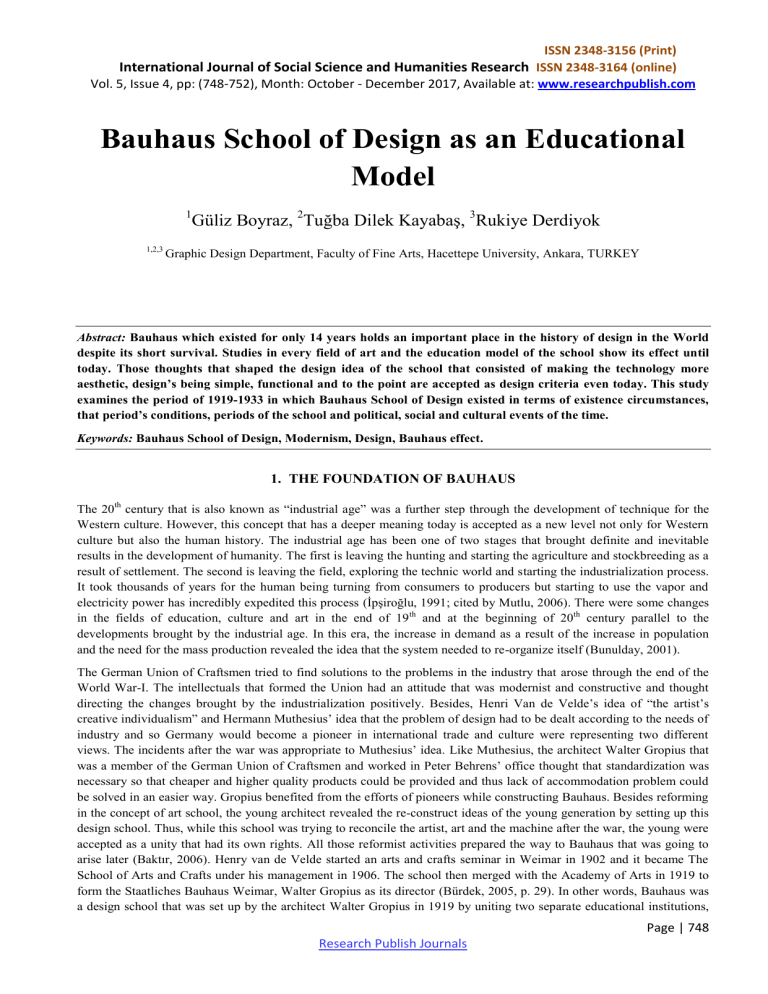
ISSN 2348-3156 (Print) International Journal of Social Science and Humanities Research ISSN 2348-3164 (online) Vol. 5, Issue 4, pp: (748-752), Month: October - December 2017, Available at: www.researchpublish.com Bauhaus School of Design as an Educational Model 1 1,2,3 Güliz Boyraz, 2Tuğba Dilek Kayabaş, 3Rukiye Derdiyok Graphic Design Department, Faculty of Fine Arts, Hacettepe University, Ankara, TURKEY Abstract: Bauhaus which existed for only 14 years holds an important place in the history of design in the World despite its short survival. Studies in every field of art and the education model of the school show its effect until today. Those thoughts that shaped the design idea of the school that consisted of making the technology more aesthetic, design’s being simple, functional and to the point are accepted as design criteria even today. This study examines the period of 1919-1933 in which Bauhaus School of Design existed in terms of existence circumstances, that period’s conditions, periods of the school and political, social and cultural events of the time. Keywords: Bauhaus School of Design, Modernism, Design, Bauhaus effect. 1. THE FOUNDATION OF BAUHAUS The 20th century that is also known as “industrial age” was a further step through the development of technique for the Western culture. However, this concept that has a deeper meaning today is accepted as a new level not only for Western culture but also the human history. The industrial age has been one of two stages that brought definite and inevitable results in the development of humanity. The first is leaving the hunting and starting the agriculture and stockbreeding as a result of settlement. The second is leaving the field, exploring the technic world and starting the industrialization process. It took thousands of years for the human being turning from consumers to producers but starting to use the vapor and electricity power has incredibly expedited this process (İpşiroğlu, 1991; cited by Mutlu, 2006). There were some changes in the fields of education, culture and art in the end of 19 th and at the beginning of 20th century parallel to the developments brought by the industrial age. In this era, the increase in demand as a result of the increase in population and the need for the mass production revealed the idea that the system needed to re-organize itself (Bunulday, 2001). The German Union of Craftsmen tried to find solutions to the problems in the industry that arose through the end of the World War-I. The intellectuals that formed the Union had an attitude that was modernist and constructive and thought directing the changes brought by the industrialization positively. Besides, Henri Van de Velde‟s idea of “the artist‟s creative individualism” and Hermann Muthesius‟ idea that the problem of design had to be dealt according to the needs of industry and so Germany would become a pioneer in international trade and culture were representing two different views. The incidents after the war was appropriate to Muthesius‟ idea. Like Muthesius, the architect Walter Gropius that was a member of the German Union of Craftsmen and worked in Peter Behrens‟ office thought that standardization was necessary so that cheaper and higher quality products could be provided and thus lack of accommodation problem could be solved in an easier way. Gropius benefited from the efforts of pioneers while constructing Bauhaus. Besides reforming in the concept of art school, the young architect revealed the re-construct ideas of the young generation by setting up this design school. Thus, while this school was trying to reconcile the artist, art and the machine after the war, the young were accepted as a unity that had its own rights. All those reformist activities prepared the way to Bauhaus that was going to arise later (Baktır, 2006). Henry van de Velde started an arts and crafts seminar in Weimar in 1902 and it became The School of Arts and Crafts under his management in 1906. The school then merged with the Academy of Arts in 1919 to form the Staatliches Bauhaus Weimar, Walter Gropius as its director (Bürdek, 2005, p. 29). In other words, Bauhaus was a design school that was set up by the architect Walter Gropius in 1919 by uniting two separate educational institutions, Page | 748 Research Publish Journals ISSN 2348-3156 (Print) International Journal of Social Science and Humanities Research ISSN 2348-3164 (online) Vol. 5, Issue 4, pp: (748-752), Month: October - December 2017, Available at: www.researchpublish.com namely Weimar Academy of Fine Arts (Grossherzogliche Hochschule für Bildende Kunst) and Weimar School of Arts and Crafts (Grossherzogliche Kunstgewerbeschule) and under the utopian slogan “The building of the future” (Ball & Ruben, 2004). Gropius was not only recognized as founder of the Bauhaus that was a school that intended to overcome the division between art and craft and the divide between art and industry but also labeled an artist-teacher for melding disciplines that did not formerly work well together (Daichendt, 2009). The name Bauhaus means Architecture House. Bauhaus School was an applied fine arts school that developed the modern thought and an art culture center. Bauhaus was also defined as the home where modernism was born (Tok, 2007; Ozan, 2009). The idea of Bauhaus was explained as follows in the manifestation of Bauhaus: “The main aim of all visual arts is to contribute to the integrity of the structure. In the past, the noblest function of the fine arts was decorate the constructions; they were irreplaceable elements of architecture. Today, there is not a connection among the arts. Architectures, artists and sculptors have to learn the composite characteristic of the construction as a new concept. The artist is an artisan that has shifted his art to the higher level. The basic for each artist is to be the master in his/her art. The first resource of creative design is this characteristic” (Kara, 2009). Among the first aims of Bauhaus was renewing of architecture, design and city design (Altet, 2006). 2. BAUHAUS EDUCATION The aim of Gropius was reconstructing existing values of modern human and society. Therefore, Bauhaus that was founded with Gropius‟ mentioned understanding and aim used to emphasize using art and technique together in the education so handicraft was very important in this sense. Gropius explains it perfectly by saying that the art is exaltation of handicraft (Artun & Aliçavuşoğlu, 2009). Gropius was a modernist and thought that the modern world needed a new, functional and practical aesthetic within all the chaos (Farthing, 2014). Bauhaus was a state institution but completely different from art schools founded by the state (İprişoğlu, 1978; cited by Ekren, 2006). In Bauhaus school, the education was given in workshops on the fields of smith craft, carpentry, weaving, pottery, stained glass, mural painting, scene design and decoration, theatre and graphic design under three main field of art, namely architecture, painting and sculpture. The education in the school was consisted of three main stages as preparatory education (basic art education), technical education (vocational art education) and structural education (studies on the profession, project studies) (Bulat, Bulat and Aydın, 2014). It is especially important to examine “Vorkurs” (Foundation Course) that was the basic education within the Bauhaus education system (Bektaş, 1992; Lerner, 2005) and it is discussed as a versatile, enduring prototype for combining art, design, and architectural studio education in the American K-12 curriculum (Lerner, 2005). Boucharenc (2006) explains the difference and probably importance of that kind of education as: “Basic Design can often be enhanced more by the curiosity and experiences of students than by the theoretical content of the subject matter taught. … this form of teaching and learning develops the creative spirit of students by introducing them to shapes, colors, rhythm, and light outside of any academic approach, and by allowing them to discover a personal bond with various materials.” 3. PERIODS OF BAUHAUS Bauhaus that was a school in which new movements in architecture, design and art in the 20 th century was also a center of production thanks to bringing the most distinguished and modern architects and artists together. Different architects, namely Walter Gropius (1919-1928), Hannes Meyer (1928-1930) and Mies Van der Rohe (1930-1933) directed the school of Bauhaus that functioned at three different schools (1919-1925 Weimar, 1925- 1932 Dessaus, 1932-1933 Berlin) (Kara, 2009). Weimar period in Bauhaus was a time in which many projects were put into practice. The basic of the education system was teaching the main principles of design and handicraft and co-working of the designer and the artisan. The basis for the study programs in Bauhaus was basic art education beginning course that lasted six months. The other important feature of the school was its letting the students do handicraft applications at the workshops in order to provide them to know the industry, material, modern production problems closely. At the workshops, the productions created by using stained glass, wood and metal were taught and controlled by artists and artisans together (Bektaş, 1992). The underlying thought of Bauhaus was unity in art and applied education. After selecting a workshop depending on their skill, every student had to finish the preliminary course whose directors were the artist and the artisan. Prototypes were Page | 749 Research Publish Journals ISSN 2348-3156 (Print) International Journal of Social Science and Humanities Research ISSN 2348-3164 (online) Vol. 5, Issue 4, pp: (748-752), Month: October - December 2017, Available at: www.researchpublish.com developed as a result of the direct combination of design parameters with applied experiences. Industrial production manufacturing of Bauhaus workshops was licensed especially in Dessau period (Baktır, 2006). In the preliminary art course, the artist and the artisan started the training together and students were provided to understand the basic features of the materials. The first teachers of the preliminary art course were important artists such as Itten, Schlemmer, Kandinsky and Klee that were the pioneers of abstract expressionism movement. The experimental productions that were manufactured under the leading of those artists and by pushing the basic elements and many materials to their limits left its mark on this period. That basic education which lasted two semesters was mandatory for all students. The works carried out in that stage were crucial as they formed the basis for technical education and future art and design works (Bulat, Bulat, & Aydın, 2014). The aims of Bauhaus that included romantic and idealist ideas changed in time. The personal expressions and romantic concepts were replaced by more rationalist and scientific opinions especially from 1923 to the end of 1925. However, towards the end of 1925, Bauhaus was directly affected by inner contradictions and external pressure from the policy. The school could not stay in Weimar any more due to those reasons and moved to Dessau (Baktır, 2006). Bauhaus school was opened in Dessau in its new building that was designed appropriate to the Bauhaus teaching principles and became the symbol of Bauhaus in 1926. The Bauhaus building in Dessau was completely different from the one in Weimar. The school building that was designed by Gropius and Adolf Meyer was a simple, functional and assertively modern structure (Ozan, 2009). In 1923, Gropius explained the theoretical model in which the philosophy of the Bauhaus was grounded in the international exhibition held in Weimar: “Art and Technology: A New Unity” (Findeli, 2001). While Bauhaus moved to Dessau in 1926, Gropius summarized the fundamentals of the renewed curriculum as “The modern human that wears not the dresses of the past but the modern dresses needs a modern house that is equipped with modern daily tools and appropriate to himself and the age. The nature of an object is identified by its use. For a container, chair or house to function properly, its nature should be examined first. Because, the object should perfectly serve its aim. In other words, it should function practically, be cheap, durable and „beautiful‟” (Baktır, 2006). The identity and philosophy of Bauhaus reached a complete maturity in Dessau period. Bauhaus was influenced by De Stijl and Constructivism to a large extent and not only copied those styles but also comprehended their stylistic principles and turned them into a form that could be applied to design problems. In 1926, Bauhaus was named as Hochschule für Gestaltung (College of Design) and masters were called as professor then, which indicated leaving master-apprenticeforeman system of the Middle Age (Bektaş, 1992). In 1927, Bauhaus started architecture education by the arrival of Meyer from Switzerland. Thanks to its emphasize on rationalist and purist forms, functionality and technology, Bauhaus school contributed to the international style of 1930s in architecture to a large extent (Ozan, 2009). However, Meyer resigned due to conflicts with local authorities in 1930 and was replaced by Berliner architect Mies Van Der Rohe. Using the motto “multum in porvo” (much in little), Van Der Rohe composed the main style of Bauhaus and 20th century architecture. In 1932, Nazi party started to force over the Dessau city council and the contract between Bauhaus and the party was canceled. Although Mies van der Rohe tried to continue to the education by moving Bauhaus to an empty telephone factory in Berlin Stieglitz, Nazi attacks made it impossible and Bauhaus was closed on 10 August 1933. Thus, the most important design school of the 20 th century ended its education. Many of the Bauhaus members that included intellectuals and artists moved to the USA and other countries because of the increasing pressure from the Nazis (Bektaş, 1992). Following World War II, the Bauhaus philosophy that based on finding a balance among art, science, and mass production was significantly supported by leading art and design critics in the US. The Bauhaus immigrants formed several branches and influenced design across the American landscape, and indeed their school became one of the most influential design movements in the world (Vogel, 2009). 4. THE EFFECTS OF BAUHAUS Before going to the USA, Gropius and Breuer went to England in 1934 and tried to restore ideas and methods together with the its teachers and students. Moholy-Nagy founded the new Bauhaus in Chicago in 1937 and the design school in 1939 (Ilinois Institute of Technology). Gropius lectured at Harvard between 1937 and 1952 and opened an architecture office in 1945. Albers lectured at Black Mountain College and Yale. Besides, a Bauhaus exhibition was organized at New York Fine Arts Museum in 1938. Bayer finished his career as a graphic designer in the USA in 1938. Breuer worked as an architect together with Gropius in New York between 1937 and 1941. Then, he opened his own office. The students, on the other hand, scattered at architecture offices, advertisement agencies and art schools (Ozan, 2009). Page | 750 Research Publish Journals ISSN 2348-3156 (Print) International Journal of Social Science and Humanities Research ISSN 2348-3164 (online) Vol. 5, Issue 4, pp: (748-752), Month: October - December 2017, Available at: www.researchpublish.com Bauhaus abolished the border between fine and applied arts and aimed to prepare an environment that let the interaction between the two. The education at Bauhaus was organized on workshop studies that would lead to develop the individual‟s skills. The aim of the workshop studies was not only training the individual as an artisan. The workshops were used like research laboratories and the needs of the industry were fulfilled in those workshops. Designs were created at Bauhaus to fulfill the needs of the industry for the first time. After pioneering sample works on textile, glass and ceramic, the production was moved into the factories. Thus, people had a chance to use products that were designed by artists (Artun & Aliçavuşoğlu, 2009, p. 17-18). Thanks to innovative understanding that it brought to the school of design, Bauhaus linked art, architecture and industry and provided art to take place in many different fields from architecture to textile, graphics to furniture, ceramic to sculpture and drawing to industrial design. The aim of the Bauhaus that was a school of training was to spread modern culture thought into all the fields of life through the designed new forms. The primary concern of the school that was accepted as an address where the fine arts and useful products came together was to provide quality products through design and that concern caused the emergence of the approach that relied on simple, light, functional and aesthetic fundamentals and might be called as “Bauhaus Style” (Baktır, 2006). Bauhaus created a modern design style that affected and actualized architecture, product design and visual communication. The school that approached the visual education with a modern attitude contributed to the industry largely through adding preparatory and preliminary education, its authentic teaching methods and a brand-new understanding of visual theory. Bauhaus combined fine and applied arts and aimed to integrate the art with the life through design. By that, they believed to contribute to the social change and cultural revival (Kara, 2009). The school approached to the fabricated products‟ problem of being away from aesthetic caused by industrial revolution with intelligent solutions and showed that those products could be simple and aesthetic at the same time through the products they designed. The designs for the mass production were appropriate to the conditions of the age and could fulfill the needs. The designers and students trained at the school prepared prototypes for the daily used objects and developed them. The school was the pioneer of the modernism by its designs that were away from all vanity and ornament (Ozan, 2009). Ulm school that was under the effect of Bauhaus was founded in Germany in 1953. In its beginning years, Gropius‟ effects and guidance were important factors. Beginning years included a curriculum in line with Bauhaus. The school consisted of previous professors and some young assistant professors of Bauhaus. In the school, in 1960s, theoretical and practical disciplines were formed and projects were received from and applied to the industry. That was the period when German industry explored and benefited from Ulm‟s design approach. Similar to the destiny of Bauhaus but due to different reasons, the school was closed 15 years later in 1968. After the school was closed, lecturers and students distributed Ulm idea to Germany, Europe and many countries in the world. Those especially included the design schools in Germany and educational institutions in Italy, Mexico and Latin America, Japan and Far East. The underlying thought and design approach of Bauhaus affected firstly its own period, then German design culture through the contributions of Ulm and German industry. Besides, it also affected the design culture of the modern age indirectly (Artun & Aliçavuşoğlu, 2009). Such a development in Turkey was village institutions. The village institutions that were founded in 1940 were based on the cooperative education of Bauhaus. They were founded to train teachers to the primary schools in every corner of Turkey. They provided to train people on technical issues with the motto “training within the work for work” starting from 1940. It was believed that the education would not be beneficial for either the individual or the society as long as it did not include observation, experiment, work, production, and creativity. Therefore, the education was given while works were completed and artifacts were created (Karabıyıkoğlu & Boduroğlu, 2010). The graduates were going to be pioneers of creative cooperation in their villages and help the increase in self-awareness and development of the villagers. After a short time, unfortunately, those institutions that showed the Bauhaus principle could bring important development in agriculture faced reactions from conservatives and were closed in 1947 (Kara, 2009). One of the common points of Bauhaus and village institutions was their understanding of education within application, thus they aimed to feature students‟ abilities. 5. CONCLUSION Bauhaus school was founded in 1919 and actively functioned in Weimar, Dessau and Berlin cities until 1933 when it was closed. Bauhaus was born as an idea for the needs of new social order that was the result of industrial revolution. It took the art out of the academy and museums and brought it to the halls of our houses as parallel to its understanding that Page | 751 Research Publish Journals ISSN 2348-3156 (Print) International Journal of Social Science and Humanities Research ISSN 2348-3164 (online) Vol. 5, Issue 4, pp: (748-752), Month: October - December 2017, Available at: www.researchpublish.com emphasizes the realization of the art in the life. Therefore, the pioneer side of the art had a direct relation with the daily life. Bauhaus that revived an art that included the whole life of the human being from social residence to the simplest daily tools combined the art, society, industry and handicraft as a school of design. The sphere of influence created by Bauhaus was also important in terms of arts education institutions. Today, it is possible to say that Bauhaus is a model for many schools of art education. In this sense, Bauhaus is an idea movement that has not lost its effect even today. That innovative school inevitably affected Turkey that just came out of the independence war and tried to renew itself through many revolutionary reforms and that resulted with the foundation of village institutions. It is possible see the marks of school of Bauhaus in today‟s many simple, functional and affordable designs and it does not seem possible to guess how long the design principles of Bauhaus school of design will affect the architecture and design. REFERENCES [1] Altet, X. B. (2006). Sanat Tarihi. Ankara: Dost Yayınları. [2] Artun, A., & Aliçavuşoğlu, E. (2009). Bauhaus: Modernleşmenin Tasarımı. İstanbul: İletişim Yayınları. [3] Baktır, Ö. (2006). Bauhaus Felsefesi ve Endüstriyel Tasarımdaki İşlevsellik Boyutu. Antalya. [4] Ball, P., & Ruben, M. (2004). Color Theory in Science and Art: Ostwald and the Bauhaus. Angewandte Chemie, 40(37), 4842-4847. [5] Bektaş, D. (1992). Çağdaş Grafik Tasarımın Gelişimi. İstanbul: Yapı Kredi Yayınları. [6] Boucharenc, C. (2006). Research on Basic Design Education: An International Survey. International Journal of Technology and Design Education, 16, 1-30. doi:10.1007/s10798-005-2110-8 [7] Bulat, S., Bulat, M., & Aydın, B. (2014). Bauhaus Tasarım Okulu. Atatürk Üniversitesi Sosyal Bilimler Enstitüsü Dergisi, 105-120. [8] Bunulday, S. (2001). Bauhaus'un Türkiye'deki Sanat Eğitimine Etkileri ve Yansımaları. İstanbul: Mimar Sinan Üniv. Sosyal Bilimler Enstitüsü. [9] Bürdek, B. E. (2005). Design: History, Theory and Practice of Product Design. Berlin: Publishers for Architecture. [10] Daichendt, G. J. (2009). Redefining the Artist-Teacher. Art Education, 62(5), 33-38. [11] Ekren, S. (2006). Türkiye’de Bir Eğitim Modeli “Bauhaus”. İstanbul. [12] Farthing, S. (2014). Sanatın Tüm Öyküsü. İstanbul: Hayalperest Yayınları. [13] Findeli, A. (2001). Rethinking Design Education for the 21st Century: Theoretical, Methodological, and Ethical Discussion. Design Issues, 17(1), 5-17. [14] Kara, İ. M. (2009). Türkiye ve Uluslararası Bauhaus Sanat Ve Tasarım Fakültelerinde Grafik Eğitimi Program İçerikleri Ve İşleyişler. İstanbul. [15] Karabıyıkoğlu Boduroğlu, S. (2010). Türk Sanat Eğitiminin Tarihsel Gelişimi ve Bauhaus Ekolünün Türk Sanat Eğitimine Yansımaları. Eskişehir. [16] Lerner, F. (2005). Foundations for Design Education: Continuing the Bauhaus Vorkurs Vision. Studies in Art Education, 211-226. [17] Ozan, M. (2009). Bauhaus Okulu Ve Erken Cumhuriyet Dönemi Mimarisi - İç Mimarisine Etkileri. İstanbul. [18] Vogel, C. M. (2009). Notes on the Evolution of Design Thinking: A Work in Progress. Design as integral to Business success, 20(2), 16-27. Page | 752 Research Publish Journals
